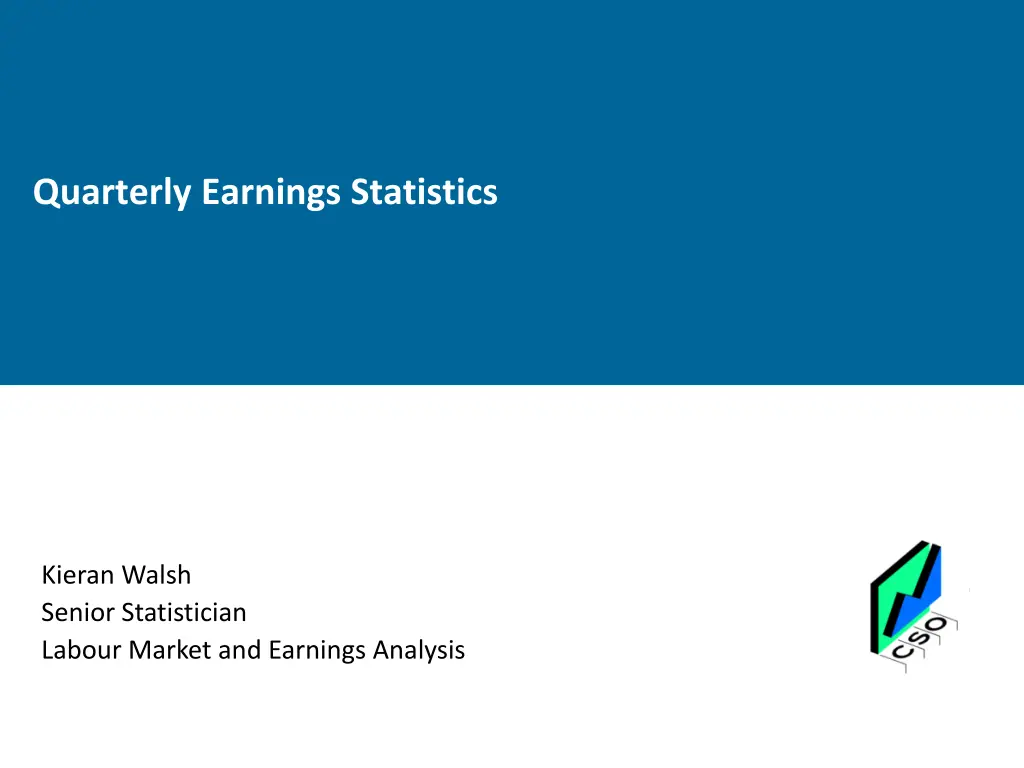
Quarterly Earnings Statistics Analysis by Senior Statistician Kieran Walsh
Explore the comprehensive analysis of quarterly earnings statistics by senior statistician Kieran Walsh. Learn about data collection methods, primary indicators, and key statistics on average weekly earnings by sector from Q1 2008 to Q4 2010. Dive into the details of earnings surveys, labor costs, and employment trends to gain valuable insights into the labor market dynamics.
Download Presentation

Please find below an Image/Link to download the presentation.
The content on the website is provided AS IS for your information and personal use only. It may not be sold, licensed, or shared on other websites without obtaining consent from the author. If you encounter any issues during the download, it is possible that the publisher has removed the file from their server.
You are allowed to download the files provided on this website for personal or commercial use, subject to the condition that they are used lawfully. All files are the property of their respective owners.
The content on the website is provided AS IS for your information and personal use only. It may not be sold, licensed, or shared on other websites without obtaining consent from the author.
E N D
Presentation Transcript
Quarterly Earnings Statistics Kieran Walsh Senior Statistician Labour Market and Earnings Analysis
Outline of Presentation 1. Data collection 2. Primary indicators 3. Additional indicators
Quarterly earnings data collection Historically multiple earnings surveys Covered different sectors (public sector, industry, building, distributive trade, financial services) but not comprehensive Different methods and coverage No all sectors estimation possible Earnings hours and employment costs survey (EHECS) initiated in 2005 initially covered industry and finance In Q1 2008 extended to all sectors of the economy
Quarterly earnings data collection contd. EHECS collects information on the following main elements from enterprises with 3+ employees: Regular earnings Irregular earnings Other labour costs Paid hours Employment Broken down full time/part time and 3 occupational groups Aggregate level information collected
Quarterly earnings data collection contd. Data collected from all enterprises with 50 or more employees Sample of smaller enterprises High burden survey done according to Labour Costs Survey framework (detailed) no separate LCS required In 2009/2010 a number of steps taken to reduce burden Reduced sample Reduced form for smaller enterprises Done so as to maintain key outputs Improved timeliness as a result
Quarterly earnings statistics key indicators weekly earnings Average weekly earnings by sector, Q1 2008 to Q4 2010 1,200.00 1,000.00 800.00 Total Private sector Public sector 600.00 Less than 50 employees 50-250 employees Greater than 250 employees 400.00 200.00 0.00 Q108 Q208 Q308 Q408 Q109 Q209 Q309 Q409 Q110 Q210 Q310 Q410
Quarterly earnings statistics key indicators weekly earnings Average weekly earnings overall down over the period Private sector steadily down during 2008/9 fluctuating in 2010 Public sector up in 2008, fluctuated 2009 (excluding pension levy effect), down in 2010 following pay cut By size class all fluctuating but no major pattern Average weekly earnings by sector, Q1 2008 to Q4 2010 1,200.00 1,000.00 Total 800.00 Private sector Public sector 600.00 Less than 50 employees 50-250 employees Greater than 250 employees 400.00 200.00 0.00 Q108 Q208 Q308 Q408 Q109 Q209 Q309 Q409 Q110 Q210 Q310 Q410
Quarterly earnings statistics key indicators hourly earnings Average hourly earnings by sector and size class, Q1 2008 to Q4 2010 35.00 30.00 25.00 Total 20.00 Private sector Public sector Less than 50 employees 15.00 50-250 employees Greater than 250 employees 10.00 5.00 0.00 Q108 Q208 Q308 Q408 Q109 Q209 Q309 Q409 Q110 Q210 Q310 Q410
Quarterly earnings statistics key indicators hourly earnings Paid hours have been cut most notably in private sector and smaller enterprises As such some of cuts in weekly earnings not replicated in hourly earnings Most notable shift in hourly earnings in public sector where pay cut shifted level down in 2010 Average weekly earnings by sector, Q1 2008 to Q4 2010 1,200.00 1,000.00 Total 800.00 Private sector Public sector 600.00 Less than 50 employees 50-250 employees Greater than 250 employees 400.00 200.00 0.00 Q108 Q208 Q308 Q408 Q109 Q209 Q309 Q409 Q110 Q210 Q310 Q410
Interpretation issues Refers to remaining enterprises and employees Some queries regarding loss in earnings for people who used to work in Construction cannot be estimated from this source Composition effects difficult to estimate without high burden on respondent enterprises would require very detailed occupation, experience etc. information Trends not unidirectional e.g. reduction occur in some periods and not others
Supplementary analysis Looked at wage bill changes among enterprises who were available in both periods Enterprises cut/increase wage bill in 3 ways Employment Paid hours Hourly earnings Used data for Q3 2008 and Q3 2009 period of greatest employment loss Showed that 65% of all enterprises cut their wage bill by more than 2% 68% small enterprises, 57% large enterprises
Supplementary analysis from EHECS Percentage of enterprises reducing their wage bill and components of the wage bill, by components changed, Quarter 3 2008 to Quarter 3 2009 54% Employment 12% 13% 20% 9% Average Average Hours Hourly Earnings 4% 4% 3% 37% 29%
Supplementary analysis Many enterprises cut more than one of the components Employment most frequent (more than half of enterprises cut their wage bill with an employment reduction as part of it) Paid hours next most frequent (37%) Hourly earnings least frequent (29%) and hourly earnings (standardised actually increased 1% over the period) Varied greatly across sectors Compositional effect also looked at with available information no significant compositional effect identified
